The iPhone 7 and iPhone 7 Plus Review: Iterating on a Flagship
by Joshua Ho & Brandon Chester on October 10, 2016 8:00 AM EST- Posted in
- Smartphones
- Apple
- Mobile
- iOS
- iOS 10
- iPhone 7
- iPhone 7 Plus
System Performance
Section by Brandon Chester
At the heart of a smartphone lies the SoC. While there's now an increasingly common belief that specifications don't matter, the truth of the matter is that almost all of the software features that users now take for granted in a smartphone have only been made possible by the continued improvements in hardware performance. Modern smartphones with high resolution displays and complex interfaces would not exist if the available CPU and GPU processing power hadn't advanced as much as it has. On top of that, performance is something of a gating factor for software development, as the innovation that happens in software has to happen within the boundaries of what can be done with the hardware. Specifications in a smartphone actually matter quite a lot, even if the user isn't actively aware of all the individual components that make up their smartphone's SoC.
With the iPhone 7 Apple doesn't have the benefit of a new major process node to help improve performance. Any improvements will be the result of architectural improvements, as well as improvements that have been made to TSMC's 16nm process since the release of the Apple A9, which was Apple's first FinFET SoC. It's important to note that one of the goals of A10 Fusion is improving dynamic range, so the focus isn't solely on improving performance. However, device performance seemingly must improve with each generation, and Apple is advertising a 40% improvement in CPU performance and a 50% improvement in GPU performance with A10 Fusion compared to A9.
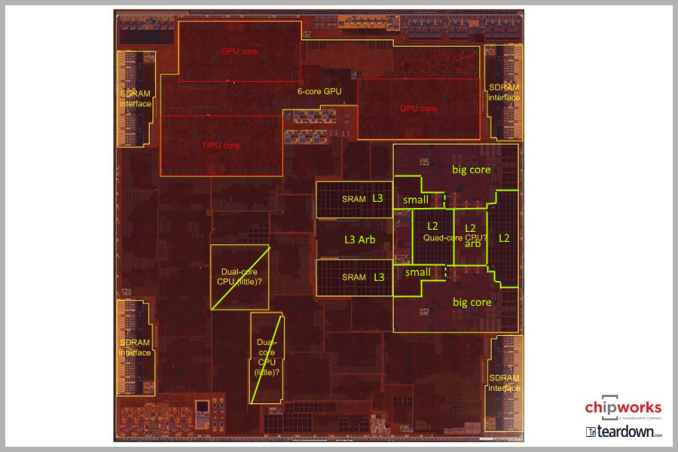
A10 Fusion's Floorplan (Special thanks to Chipworks)
While an in-depth look at A10 Fusion will have to wait until our seperate technology deep dive, we can still take a look at how performance has changed at a higher level. A10 Fusion's peak frequency is 2.3GHz, up from 1.8GHz on A9. This gives a theoretical improvement of 28% on its own, and the remainder will have to come from improvements to the architecture in Apple's (big) Hurricane cores. Based on our testing so far, Hurricane is not radically different from Twister (A9), but Apple has been making some optimizations. Meanwhile it should be noted that while A10 technically has four CPU cores – the two Hurricane cores and the two smaller cores – this is not a heterogeneous design, and only two cores are active at once. So for the purposes of high performance benchmarking, this means we're benchmarking the big cores nearly exclusively.
Anyhow, we've run our standard suite of benchmarks on the iPhone 7 and 7 Plus to see if A10 Fusion stands up Apple's performance claims.
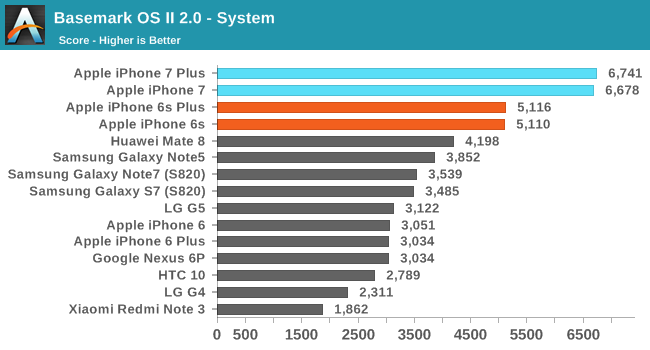
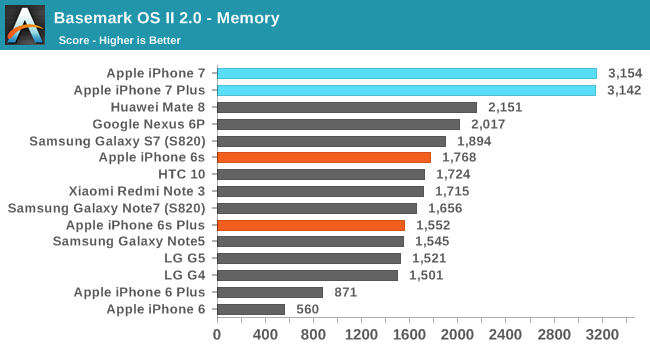
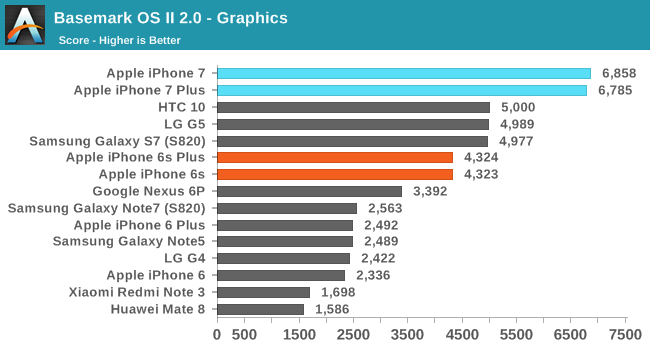
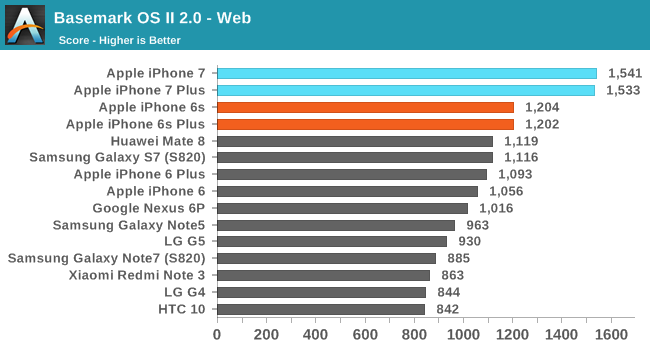

I've brought back BaseMark OS II for this review, although unfortunately the reason has less to do with wanting it back in the benchmark suite and more to do with there being very few cross-platform general system benchmarks nowadays. You can focus on the GPU, or the CPU, but the major system performance benchmark in mobile is PCMark and it remains exclusive to Android. BaseMark OS II is a pretty large optimization target now, and while it does test many aspects of the system it doesn't do so by directly simulating the tasks that a user would perform. Despite that, it helps in getting a holistic view of a device's performance by going beyond tests of a single component, so it's not without its uses.
The iPhone 6s and 6s Plus have remained the fastest overall devices in this test, so it's really just a matter of seeing how much Apple has improved. The latest generation of Android devices outpaced the GPU performance Apple's A9 SoC some time ago, so that's one area where Apple could stand to improve against the competition. As it turns out, they have. The iPhone 7 and 7 Plus show significant gains over their predecessors across the board. Performance in the system sub-test is up by 25-30%, and the graphics score is right in line with Apple's claimed 50% increase in performance. Web shows similar gains to system, which makes sense given that both are relatively CPU-bound.
The memory/storage test also shows a large improvement, which is interesting at first glance given that Apple didn't highlight any improvements in this area. However, this is just the result of the tested units being the 256GB model. On my retail iPhone 7 which is 128GB the memory score is essentially the same as the iPhone 6s which was also tested in a 128GB configuration. This comes down to the fact that these devices use a hybrid SLC/TLC storage solution, where the SLC storage can be used for writes and data can be moved later as needed. It's likely that on the 128GB iPhones the BaseMark OS II memory test is exceeding the size of the SLC cache, leading to lower scores based on the performance of the TLC NAND. On the 256GB iPhone the SLC cache is large enough to fit the entire data set used in the test, leading to a much higher score.
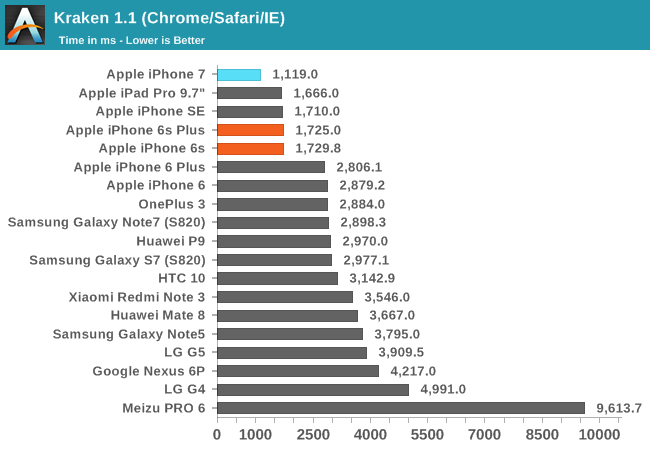
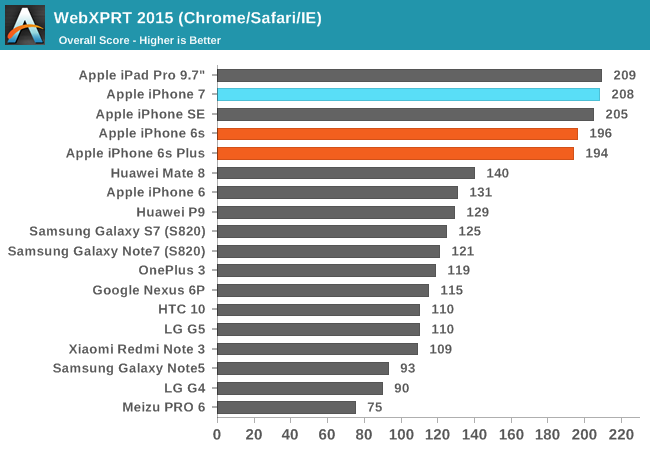
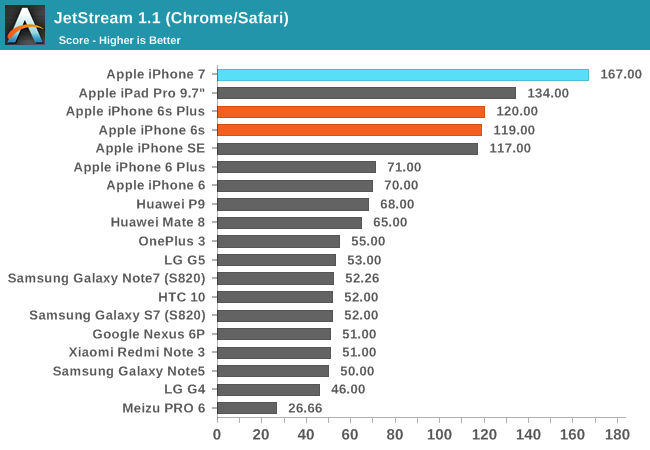
Web performance is an interesting case. While Apple's continued increases in single core CPU performance have benefited web performance with each generation, the truth is that improvements Mobile Safari's Nitro JavaScript engine have contributed a great deal as well. When looking at the charts you can see that there's a significant gap between the iPhone 7 and the next device, with the exception of WebXPRT where it's tied. What's more important than this gap is what the second device actually is. It's always another Apple device, and the same is true for the third device, and the fourth device, and so on. In Kraken and Jetstream the top seven devices on the chart are Apple's mobile devices, and the charts only have seven Apple devices in total. The Huawei Mate 8 is able to move ahead of the iPhone 6 in WebXPRT, but the gap between it and the iPhone 6s is still enormous. While Apple has continued to advance their web performance, it hasn't been with the immediate goal of beating the Android competition, as the best Android devices are still just trading blows with the iPhone 6.
WebXPRT is a small exception. As far as mobile benchmarks go, it's quite long and has short bursty workloads with pauses between each to simulate how a user would pause between different actions while using the browser. I suspect that in this case we're seeing the effects of A10 switching between its low power and high performance cores, causing parts of the test to be run on the little cores, which are not as performant. In fact, In the case of very quick actions that take only tenths or hundreths of a second to complete, it may not be possible to switch to the high performance cores before the operation has ended, causing the score to reflect the performance of the low power cores instead.
While it might seem reasonable to attribute the superior web performance of iOS devices to Apple's focus on improving single threaded CPU performance, the fact that Android devices with Cortex A72 CPUs are only matching Apple's A8 SoC shows that the gap is not only due to the CPU power available. Chrome's generally poor performance on Android is a significant limiting factor, and you can see in the chart how the improvement in Android device CPU performance over time has not translated into anything close to the sorts of gains that Apple has seen in the same period. While there are customized versions of Chromium like Snapdragon Browser that provide optimizations for a class of SoCs, it doesn't look like the gap between Android devices running Chrome and iOS devices running Mobile Safari is going to close any time soon, and if anything, it's only widening with each year.


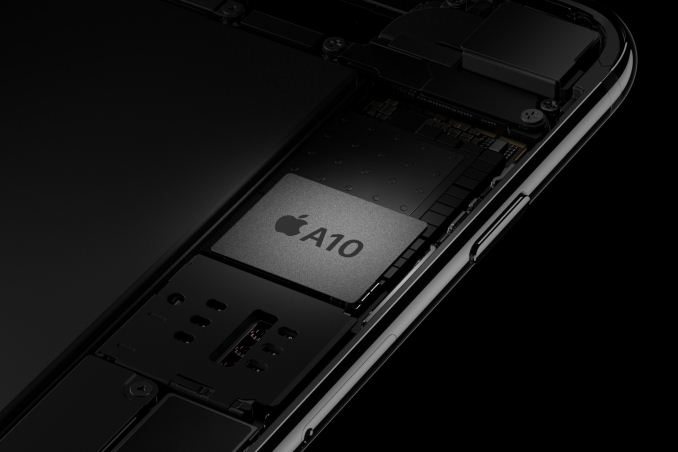








377 Comments
View All Comments
lolipopman - Tuesday, October 11, 2016 - link
I agree that Apple rules the market currently.*Currently*. It actually seems that the recently announced ARM A73 will be a beast.
And let's not forget the Mali G71 which is said to be very close to Nvidia Shield's performance.
I'm curious what the A11 chip will be bringing to the graphics table when the next revision of iPhones drop.
jospoortvliet - Tuesday, October 11, 2016 - link
Sadly the A73 won't even make a dent, it is maybe 20% faster at same power, that isn't a third of the gap with Apple...GPUs are doing better indeed but with far higher pixel densities end user experience is still that much worse.
tuxRoller - Tuesday, October 11, 2016 - link
Unfortunately it won't. The a73 looks to be quite good at efficiency, but per clock perf is still going to be decently far behind.As for graphics, no one can match IMG for efficiency. I really wish arm/Softbank would buy IMG.
ex2bot - Wednesday, October 12, 2016 - link
Android has been competitive in many areas and just plain better in some important ones (customization, screen quality, flexibility, choice), but the truth is that Qualcomm fell behind in perf with the 810 and 820. It looks like the 821 is close in performance.Secondly, the 7 and 7 Plus are most likely going to show better battery life because they have bigger batteries than the 6s and 6S Plus.
CloudWiz - Thursday, October 13, 2016 - link
821 is just a clocked-bumped 820, the performance difference between 820 and 821 will be less than 10%. Kryo is currently twice as slow as Hurricane in ST and far less efficient.cknobman - Monday, October 10, 2016 - link
I'm just going to reference this: http://www.windowscentral.com/best-smartphone-came...This was a blind test of over 13000 people voting on pictures taken in many many different scenarios. It compared 4 of the top smartphone cameras (which one of which was the iPhone 7).
The Galaxy S7 won by a landslide, not even close.
The iPhone 7 has its own drawbacks largely ignored by this review.
The lack of a headphone jack is a bigger issue that anyone makes it out to be and iOS is a terribly hindered OS that makes using any iPhone an painful experience.
Sure the battery life is good/great but this is largely because Apple choosing to remain so far back in their resolution. If you live in a Apple box and only look at their devices then sure its fine.
But go use any of the dozens of non Apple phones out there and then come back to an iPhone (especially the plus) and you immediately notice the lowered resolution and display quality.
The Garden Variety - Monday, October 10, 2016 - link
I was in tears and the injustice of this "review" until I read your supportive, nurturing reply. Thank you for giving all of us hope. Hope that the truth will reign, and that someday tech "journalists" will be exposed and jailed for their obvious bias. JAILED.cknobman - Monday, October 10, 2016 - link
LOL Your butthurt was so painful it seems you could not even comprehend what I wrote.I never called out the reviewer for bias or injustice but you apparently only choose to read/see/envision what you want...............either that or you are just plain stupid.
grayson_carr - Monday, October 10, 2016 - link
Let me propose a scenario. You have two identical displays. One is perfectly calibrated. One has the color saturation boosted and does not display colors accurately. If you pull a bunch of people off the street and have them look at both displays and vote on which one looks better, which one do you think they are going to pick? Answer: They are going to say the one with boosted saturation is better despite it being an identical display with objectively worse calibration. The average person does not know what is good, which is why I think blind photo comparisons are stupid. Now I'm not saying the Galaxy S7 doesn't have the best camera in a phone. The Galaxy S7 probably does have the best camera in a phone (in stills at least, video sucks). But I would much rather hear it from a professional photographer than a bunch of average Joes that know nothing about photography or cameras. That's just me.menting - Monday, October 10, 2016 - link
a professional photographer will probably feel insulted to even consider a rating a photo from a phone.